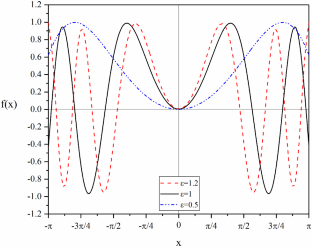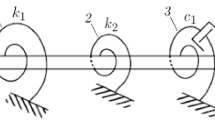Abstract
This study introduces a semi-analytical method called the New Trigonometric Radial Basis Function (NTRBF) approach to address the challenges of solving highly nonlinear differential equations in vibration problems. The method uses a particular trigonometric function to deal with differential equations in an extraordinary and original approach. This study conducted a comparative analysis of the proposed method against four different approaches, including the Global Residue Harmonic Balance Method for addressing circular sector oscillator problems, the Continuous Piecewise Linearization Method for solving highly nonlinear differential equation of a tapered beam, the Differential Transform Method for solving centrifugal rotating frame motion, and Akbari–Ganji’s Method to address Duffing-type nonlinear oscillator. These problems were solved under different conditions, and the resulting plots and tables represent both cumulative and maximum errors between the NTRBF and other methods. The numerical 4th-order Runge–Kutta method was used as a benchmark for accuracy in this comparative analysis. The outcomes prove the high accuracy and efficiency of the innovative technique and its unique capability in solving various nonlinear vibration problems.






















Similar content being viewed by others
Data Availability
The datasets used and/or analyzed during the current study are available from the corresponding author on reasonable request.
Code Availability
The datasets used and/or analyzed during the current study are available from the corresponding author on reasonable request.
References
Anjum, N., He, J.H.: Laplace transform: Making the variational iteration method easier. Appl. Math. Lett. 92, 134–138 (2019). https://doi.org/10.1016/j.aml.2019.01.016
Liu, C.S., Chang, C.W.: An energy regularization of the MQ-RBF method for solving the Cauchy problems of diffusion-convection-reaction equations. Commun. Nonlinear Sci. Numer. Simul. 67, 375–390 (2019). https://doi.org/10.1016/j.cnsns.2018.07.002
Ebrahimijahan, A., Dehghan, M., Abbaszadeh, M.: Simulation of plane elastostatic equations of anisotropic functionally graded materials by integrated radial basis function based on finite difference approach. Eng. Anal. Bound. Elem. 134, 553–570 (2022). https://doi.org/10.1016/J.ENGANABOUND.2021.10.011
Raja, M.A.Z., Abbas, S., Syam, M.I., Wazwaz, A.M.: Design of neuro-evolutionary model for solving nonlinear singularly perturbed boundary value problems. Appl. Soft Comput. J. 62, 373–394 (2018). https://doi.org/10.1016/j.asoc.2017.11.002
Kazemi, S.M.M., Dehghan, M., Foroush Bastani, A.: On a new family of radial basis functions: mathematical analysis and applications to option pricing. J. Comput. Appl. Math. 328, 75–100 (2018). https://doi.org/10.1016/j.cam.2017.06.012
Oruç, Ö.: A radial basis function finite difference (RBF-FD) method for numerical simulation of interaction of high and low frequency waves: Zakharov-Rubenchik equations. Appl. Math. Comput. 394, 125787 (2021). https://doi.org/10.1016/J.AMC.2020.125787
Liu, C.S., Chen, W., Fu, Z.: A multiple-scale MQ-RBF for solving the inverse Cauchy problems in arbitrary plane domain. Eng. Anal. Bound. Elem. 68, 11–16 (2016). https://doi.org/10.1016/j.enganabound.2016.02.011
Sun, J., Yi, H.L., Xie, M., Tan, H.P.: New implementation of local RBF meshless scheme for radiative heat transfer in participating media. Int. J. Heat Mass Transf. 95, 440–452 (2016). https://doi.org/10.1016/j.ijheatmasstransfer.2015.12.002
Jankowska, M.A., Karageorghis, A., Chen, C.S.: Improved Kansa RBF method for the solution of nonlinear boundary value problems. Eng. Anal. Bound. Elem. 87, 173–183 (2018). https://doi.org/10.1016/j.enganabound.2017.11.012
Shankar, V., Narayan, A., Kirby, R.M.: RBF-LOI: augmenting radial basis functions (RBFs) with least orthogonal interpolation (LOI) for solving PDEs on surfaces. J. Comput. Phys. 373, 722–735 (2018). https://doi.org/10.1016/j.jcp.2018.07.015
Li, N., Su, H., Gui, D., Feng, X.: Multiquadric RBF-FD method for the convection-dominated diffusion problems base on Shishkin nodes. Int. J. Heat Mass Transf. 118, 734–745 (2018). https://doi.org/10.1016/j.ijheatmasstransfer.2017.11.011
Zhang, Y.: An accurate and stable RBF method for solving partial differential equations. Appl. Math. Lett. 97, 93–98 (2019). https://doi.org/10.1016/j.aml.2019.05.021
Bhardwaj, A., Kumar, A.: Numerical solution of time fractional tricomi-type equation by an RBF based meshless method. Eng. Anal. Bound. Elem. 118, 96–107 (2020). https://doi.org/10.1016/j.enganabound.2020.06.002
Reutskiy, S., Lin, J.: A RBF-based technique for 3D convection–diffusion–reaction problems in an anisotropic inhomogeneous medium. Comput. Math. Appl. 79, 1875–1888 (2020). https://doi.org/10.1016/j.camwa.2019.10.010
Aràndiga, F., Donat, R., Romani, L., Rossini, M.: On the reconstruction of discontinuous functions using multiquadric RBF–WENO local interpolation techniques. Math. Comput. Simul 176, 4–24 (2020). https://doi.org/10.1016/j.matcom.2020.01.018
Ullah, M.Z.: An RBF-FD sparse scheme to simulate high-dimensional Black-Scholes partial differential equations. Comput. Math. Appl. 79, 426–439 (2020). https://doi.org/10.1016/j.camwa.2019.07.011
Qiao, H., Cheng, A.: A fast finite difference/RBF meshless approach for time fractional convection-diffusion equation with non-smooth solution. Eng. Anal. Bound. Elem. 125, 280–289 (2021). https://doi.org/10.1016/j.enganabound.2021.01.011
Mai-Duy, N., Strunin, D.: New approximations for one-dimensional 3-point and two-dimensional 5-point compact integrated RBF stencils. Eng. Anal. Bound. Elem. 125, 12–22 (2021). https://doi.org/10.1016/j.enganabound.2021.01.001
Ma, Z., Li, X., Chen, C.S.: Ghost point method using RBFs and polynomial basis functions. Appl. Math. Lett. 111, 106618 (2021). https://doi.org/10.1016/j.aml.2020.106618
Zeng, Y., Zhu, Y.: Implicit surface reconstruction based on a new interpolation/approximation radial basis function. Comput. Aided Geom. Des. 92, 102062 (2022). https://doi.org/10.1016/j.cagd.2021.102062
Ang, W.T.: A boundary element and radial basis function method for the Cattaneo-Vernotte equation in anisotropic media with spatially varying and temperature dependent properties. Partial Differ. Equ. Appl. Math. 4, 100138 (2021). https://doi.org/10.1016/J.PADIFF.2021.100138
Wu, H., Han, Y., Geng, Z., Fan, J., Xu, W.: Production capacity assessment and carbon reduction of industrial processes based on novel radial basis function integrating multi-dimensional scaling. Sustain. Energy Technol. Assessments. 49, 101734 (2022). https://doi.org/10.1016/j.seta.2021.101734
Uddin, M., Haq, S.: RBFs approximation method for time fractional partial differential equations. Commun. Nonlinear Sci. Numer. Simul. 16, 4208–4214 (2011). https://doi.org/10.1016/j.cnsns.2011.03.021
Kumar, S., Piret, C.: Numerical solution of space-time fractional PDEs using RBF-QR and Chebyshev polynomials. Appl. Numer. Math. 143, 300–315 (2019). https://doi.org/10.1016/j.apnum.2019.04.012
Karageorghis, A., Tappoura, D., Chen, C.S.: The Kansa RBF method with auxiliary boundary centres for fourth order boundary value problems. Math. Comput. Simul 181, 581–597 (2021). https://doi.org/10.1016/j.matcom.2020.10.010
Zhang, X., Yao, L., Liu, J.: Numerical study of Fisher’s equation by the RBF-FD method. Appl. Math. Lett. 120, 107195 (2021). https://doi.org/10.1016/j.aml.2021.107195
Tominec, I., Breznik, E.: An unfitted RBF-FD method in a least-squares setting for elliptic PDEs on complex geometries. J. Comput. Phys. 436, 110283 (2021). https://doi.org/10.1016/j.jcp.2021.110283
Zhao, W., Hon, Y.C., Stoll, M.: Numerical simulations of nonlocal phase-field and hyperbolic nonlocal phase-field models via localized radial basis functions-based pseudo-spectral method (LRBF-PSM). Appl. Math. Comput. 337, 514–534 (2018). https://doi.org/10.1016/J.AMC.2018.05.057
Fornberg, B., Larsson, E., Wright, G.: A new class of oscillatory radial basis functions. Comput. Math. Appl. 51, 1209–1222 (2006). https://doi.org/10.1016/j.camwa.2006.04.004
Buhmann, M.D., Levesley, J.: Radial basis functions: theory and implementations. Math. Comput. 73, 1578–1581 (2004). https://doi.org/10.1017/CBO9780511543241
Lu, J., Ma, L., Sun, Y.: Analysis of the nonlinear differential equation of the circular sector oscillator by the global residue harmonic balance method. Results Phys. 19, 103403 (2020). https://doi.org/10.1016/j.rinp.2020.103403
Big-Alabo, A., Ossia, C.V., Ekpruke, E.O., Ogbonnia, D.C.: Large-amplitude vibration analysis of a strong nonlinear tapered beam using continuous piecewise linearization method. J. King Saud Univ. Eng. Sci. (2020). https://doi.org/10.1016/j.jksues.2020.11.005
Ghafoori, S., Motevalli, M., Nejad, M.G., Shakeri, F., Ganji, D.D., Jalaal, M.: Efficiency of differential transformation method for nonlinear oscillation: Comparison with HPM and VIM. Curr. Appl. Phys. 11, 965–971 (2011). https://doi.org/10.1016/j.cap.2010.12.018
Mirgolbabaee, H., Ledari, S.T., Ganji, D.D.: New approach method for solving Duffing-type nonlinear oscillator. Alexandria Eng. J. 55, 1695–1702 (2016). https://doi.org/10.1016/j.aej.2016.03.007
Funding
Not applicable.
Author information
Authors and Affiliations
Contributions
HT proposed the novel method, analyzed the results, and worked on the code, and he created proper figures for the results and wrote the manuscript. MFN worked on the code. DDG supervised the whole process.
Corresponding author
Ethics declarations
Conflict of interest
The authors declare that they have no competing interests.
Additional information
Publisher's Note
Springer Nature remains neutral with regard to jurisdictional claims in published maps and institutional affiliations.
Rights and permissions
Springer Nature or its licensor (e.g. a society or other partner) holds exclusive rights to this article under a publishing agreement with the author(s) or other rightsholder(s); author self-archiving of the accepted manuscript version of this article is solely governed by the terms of such publishing agreement and applicable law.
About this article
Cite this article
Talebirostami, H., Najafabadi, M.F. & Ganji, D.D. Applying a New Trigonometric Radial Basis Function Approximation in Solving Nonlinear Vibration Problems. Int. J. Appl. Comput. Math 10, 93 (2024). https://doi.org/10.1007/s40819-024-01730-8
Accepted:
Published:
DOI: https://doi.org/10.1007/s40819-024-01730-8




